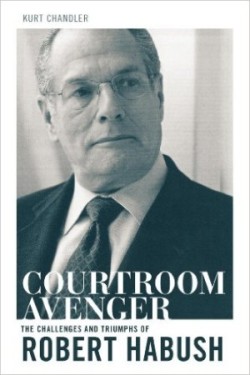
Courtroom Avenger: The Challenges and Triumphs of Robert Habush, by Kurt Chandler, , 269 pp. (2014 American Bar Association)
Books on trial lawyers hold a special fascination, providing a glimpse into a unique personality and intelligence that’s intermittently put on public display. In accident cases, most of a lawyer’s work is done outside of the courtroom. From time to time, however, some cases do proceed to trial where a jury is called upon to resolve the case. At this stage of his career, Mr. Robert Habush has nothing to prove. He has accomplished pretty much everything a Plaintiff’s lawyer could ask for: a long career with a continuous string of significant settlements and verdicts. Kurt Chandler’s new book is an inspiration: it will fire the imagination of those younger, reinvigorate those older.
From his early upbringing describing a complex relationship with his father–who “never was reluctant to slap my sisters and me if we got into some kind of mischief’–to his long string of successful product liability cases brought against auto manufacturers, a portrait emerges of a man who cannot slow down, who is incapable of taking a moment’s rest. To prove a case against Chrysler for failing to install a three–point seat belt with shoulder restraints, Mr. Habush had his investigator travel “to Europe to purchase a 1988 Chrysler minivan and ship that thing back to Milwaukee in a metal box.” To prove a case against a maker of 100-percent cotton pajamas not treated with flame retardant, he had his investigator travel to Cookeville Tennessee and discovered that the correct manufacturer was “in fact operating a garment plant in Cookeville under the alias of ‘the Cannon brothers.’”
Always beneath the surface a latent anger simmers, a deep-seated resentment which finds its expression when some measure of justice has been meted out. Personal injury lawyers will never be understood by the general public. Nor should they be. They are called upon only when things go drastically wrong. And those in power prefer not to have their power questioned. But as this book shows cases challenging unsafe products and practices have made a difference. Mr. Chandler lists three pages of changes brought about by lawsuits that have made products safer, everything from exploding bottle caps to safer child seats to safety interlocks on industrial equipment. While not explicitly stated, one senses the marked degree of resistance that was encountered over a period of many years and the amount of time and energy that was needed to bring about the change in thinking where safety is now routinely considered in the design of a consumer product.
The book ends with a detailed explanation of Mr. Habush’s representation of the families of three ironworkers who were killed in 1999 when a 567-foot tall crane nicknamed Big Blue collapsed when attempting to lift into place a piece of roofing panel that weighed 450 tons. His work-up and presentation of the case is a model of strategic theme-based advocacy: he even hired an expert witness to testify to the pre-impact terror the ironworkers must have experienced in the seconds before their man basket struck the ground. At the end of his rebuttal argument, Mr. Habush astutely invoked a call to a better future, stating:
Members of the jury, this is the kind of case this courthouse was built for. This is the kind of case that this courtroom was designed for. This is the kind of case that I became a lawyer to handle. Something special can still come out of this tragedy. Some good may still come out of these losses. It’s in your hands, and you can ensure and send a message so that other families will not have to have me or any other lawyer standing up here talking with you like this today. We are confident, on behalf of the families, that you will do the right thing, and I thank you.
A strong sense of loyalty pervades the book: loyalty to his clients, loyalty to his friends, loyalty to his profession. “When someone is disloyal–a friend, or business associate or whatever–to me that’s unforgivable,” Mr. Habush says at one point. In today’s climate, younger lawyers can learn a great deal from this book, not the least of which is acquiring a strong sense of loyalty. Loyalty is a first virtue, one best exhibited by deeds rather than words. Ultimately, a simple life lesson to be learned from this book is this: one does not betray another. Ever. “I guess it goes under the heading of trust.”




